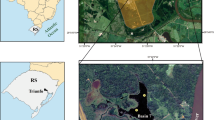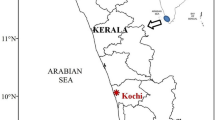Abstract
Citation of cyanobacterial cultures from the shores of south west coast of Gujarat, India and their relationship with sea water quality, influenced by extensive pollutant runoff is reported in this study. Intensity of pollution was evaluated by physico-chemical analysis of water. Higher load of suspended solids (60–1000 mg l−1) and nutrients (PO4 −P: 1.3–4 μmole l−1 and NO3 −N: 12.5–17.8 μmole l−1) were persistent throughout the analysis. Community structure is seen to be influenced by such persistent pollution. Twenty nine cyanobacterial species were isolated belonging to 9 genera of 4 families, with an elevated occurrence of Oscillatoria and Lyngbya species. No heterocystous cyanobacteria were isolated throughout the study.
Similar content being viewed by others
References
A.P.H.A.: 1995, ‘Standard Methods for the Examination of Water and Wastewater’, 19th edition, American Public Health Association, NewYork, USA.
Aboal, M.: 1989, ‘Epilithic algal communities from River Segura Basin, Southeastern Spain’, Arch. Hydrobiol. 116, 113–124.
Belkin, S.: 2003,‘Microbial whole-cell sensing systems of environmental pollutants’, Curr. Opin. Microbiol. 6, 206–212.
Carignan, V. and Villard, M.: 2002, ‘Selecting indicator species to monitor ecological integrity: A review’, Environ. Monitor. Assess. 78, 45–61.
Desikachary, T. V.: 1959, ‘Cyanophyta’, Indian Council of Agriculture Research, New Delhi, 686 pp.
Douterelo, I., Perona, E. and Mateo, P.: 2004, ‘Use of cyanobacteria to assess water quality in running waters’, Environ. Poll. 127, 377–384.
Elrich, de S.: ‘Present state of the coastal environment of India’, [Online source: http://www.teriin.org/teri-wr/coastin/discuss.htm]
Gupta, R. S. and Getangali, D.: 2000, ‘Coastal and Maritime Environments of Gujarat: Ecology and Economics’, Gujarat Ecological Society, Gujarat, India, 150 pp.
Havensa, K. E., Thomas, R. J., Easta, T. L. and Smith, V. H.: 2003, ‘N:P ratios, light limitation, and cyanobacterial dominance in a subtropical lake impacted by non-point source nutrient pollution’, Environ. Poll. 122, 379–390.
Labunska, I., Stephenson, A., Brigden, K., Stringer, R., Santillo, D., Johnston, P.A. and Ashton, J.M.: 1999, Toxic Hotspots: A Greenpeace Investigation of Gujarat Industrial Estates Organic and Heavy Metal Contaminants in Samples Taken at Three Industrial Estates in Gujarat, India.
Moisander, P. H., Hench, J. L., Kononen, K. and Paerl, H. W.: 2002, ‘Small-scale shear effects on heterocystous cyanobacteria’, Limnol. Oceano. 47, 108–119.
Murrell, M. C. and Lores, E. M.: 2004, ‘Phytoplankton and zooplankton seasonal dynamics in subtropical estuary: importance of cyanobacteria’, J. Plank. Res. 26 (3), 371–382.
Paerl, H. W., Dyble, J., Moisander, P. H., Noble, R. T., Piehler, M. F., Pinckney, J. L., Steppe, T. F., Twomey, L. and Valdes, L. M.: 2003, ‘Microbial indicators of aquatic ecosystem change: Current applications to eutrophication studies’, FEMS Microbiol. Ecol. 46, 233–246.
Rippka, S.: 1988, Isolation and Purification of Cyanobacteria, in: L. Packer and A. N. Glazer (eds.), Methods in Enzymology, Academic Press, California, USA, 167, 3–27. ISBN: 0-12-182068-8.
Rott, E. and Pfister, P.: 1988, ‘Natural epilithic algal communities in fast-flowing mountain streams and rivers and some man-induced changes’, Verh. Internat. Verein. Limnol. 23, 1320–1324.
Scheffer, M., Rinaldi, S., Gragnani, A., Mur, L. R. and van Nes, E.H.: 1997, ‘On the dominance of filamentous cyanobacteria in shallow turbid lakes’, Ecol. 78, 277–282.
Schiele, E.: 2003, ‘The Batten kill and its changing water quality’, [Online source: http://www.battenkillconservancy-ny.org]
Shah, V., Garg, N. and Madamwar, D.: 2000, ‘Record of the cyanobacteria present in the Hamisar pond of Bhuj, India’, Act. Bot. Mala. 25, 175–180.
Smith, V. H.: 1983, ‘Low nitrogen to phosphorus ratios favor dominance by blue-green algae in lake phytoplankton’, Science 221, 669–671.
Telesh, I.V.: 2004, ‘Plankton of the Baltic estuarine ecosystems with emphasis on Neva Estuary: A review of present knowledge and research perspectives’, Mar. Poll. Bull. 49, 206–219.
Vigdis, T. and Lise, O.: 2002, ‘Microbial diversity and function in soil: from genes to ecosystems’, Curr. Opin. Microbiol. 5, 240–245.
Author information
Authors and Affiliations
Corresponding author
Rights and permissions
About this article
Cite this article
Parikh, A., Shah, V. & Madamwar, D. Cyanobacterial Flora from Polluted Marine Shores. Environ Monit Assess 120, 407–414 (2006). https://doi.org/10.1007/s10661-005-9070-z
Received:
Accepted:
Published:
Issue Date:
DOI: https://doi.org/10.1007/s10661-005-9070-z




